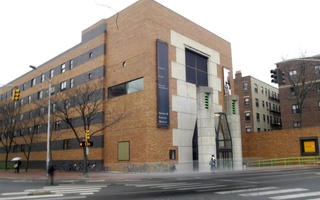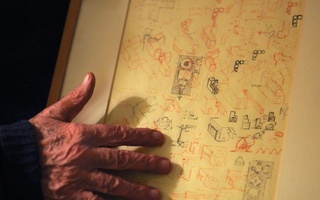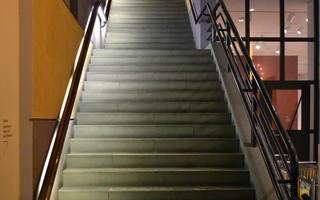The Arthur M. Sackler Museum turned festive last Thursday, as students partook merrily in the school year’s first of many such nights at the museum. Tables of pizzas, burritos, fine cheeses, and cider flanked the lobby entrance, and the evening light bathed the vaulting and cavernous space in a cozy purple glow.
Aptly named for an October event, “Science and Superstition Night at the Sackler” attracted undergraduates with the allure of free performances, activities, and copious spreads of food. One of many popular after-hours Sackler galas held by student organization Harvard Art Museums’ Undergraduate Connection (HAMUC), “Science and Superstition” gave typically occupied undergraduates a chance to relax, socialize, and, most importantly, discover the Harvard museum and its significant collections.
“The purpose is for students to be able to engage with the museum,” said Museum Educator Akiko Yamagata, the Sackler’s liaison to HAMUC. Current president of HAMUC Shannon M. Morrow ’12 added, “Many students go their entire careers without coming to [Harvard’s art museums]. The goal of these events is to promote and spread awareness.”
“Science and Superstition” struck a balance between being an educational event and a diverting study break, as playfully reflected in its title. Referring to more than its own Halloween-conscious décor, the name “Science and Superstition” also drew attention to the Sackler’s current exhibit, “Prints and the Pursuit of Knowledge in Early Modern Europe,” an inquisitive selection of scientific prints and texts from early modern Europe.
The activities held were relevant to this theme, including a scavenger hunt and printmaking. During the latter, students tried their hands at carving stencils of any subject they wished: from casual portraits of their friends to replicas of Albrecht Dürer’s famed “The Rhinoceros.” One of the exhibit’s centerpieces, the print was made after a rhinoceros sunk in the transport from Lisbon to Rome. With no rhino to observe, Dürer drew the beast from nothing but previous description and a sketch of another rhinoceros.
Alongside this lighter entertainment, the evening offered enlightening tours of the exhibit, including one led by the Sackler’s head of student affairs Susan Dackerman. “The guides are a chance for undergrads to actually see the exhibits in a comprehensive way with the curators,” said Yamagata.
Though not explicitly described in the exhibit, the theme of superstition was present in many of its pieces, as Dackerman explained. For example, the Sackler currently holds Jan Saenredam’s print of a whale beached near Beverwijk. An event like the one he portrayed may have been thought to represent a bad omen by early modern Europeans.
Though her tour touched on only a few of the exhibit’s main attractions in the brief time allotted, Dackerman gave thorough explanations and emphasized each piece’s greater connection to its utility and the people surrounding it. One highlight was the demonstration of how one could fashion an authentic sundial out of a print cut-out. Later in the evening, student guide Benjamin B. Wilcox ’13 demonstrated his own guide chops and gave two more highly informative tours for students who came in the event’s second hour.
A common theme ran through Dackerman and Wilcox’s tours: from explaining important inventions to medical dissections, prints were integral as ways for both the scientific and popular community to conceptualize ideas or images. Prints were a way to pass knowledge, to explain that which was not otherwise available or communicable: a print could show someone a whale or rhinoceros, whether they had seen one in reality or not.
As prints attracted the Europeans to science, HAMUC’s free fete attracted students to the Sackler. Besides Thursday, HAMUC continues to promote the arts, throwing two or more museum nights each year. Lately, as Morrow explained, the club has been posting career-related events and internship lists for the arts and expanding the panels and curator dinners it hosts. The students appreciated the opportunity to explore the Sackler outside its usual schedule. “It’s a challenge to get [to the Sackler] when there are classes,” said Ashleigh J. Cote ’15. “I tend to look out for these events… I come here for the tours [to be] able to see the pieces with someone and then admire them more.”
Overall, the museum setting brought out a convivial spirit. “Science and Superstition” at the Sackler provided a refined rest from busy classes. It appealed to the senses, intelligence, and creativity. Attendees were jostled from one scheduled attraction to another; they toured the third floor gallery, scrambled down for some food and a performance by The Harvard-Radcliffe Veritones, and then went to the basement to draw prints. The end of the evening held almost a nostalgic air, akin to that accompanying childhood days at camp with the freedom to choose from a great itinerary of exciting things to do.
Read more in Arts
‘Take Shelter’ is an Engrossing ThrillerRecommended Articles
-
Sackler Turns To PodcastsWhen Ptolemy I founded the world’s first museum at Alexandria in 280 BC, he could have had no idea museums
-
 A Night at the Sackler Museum
A Night at the Sackler Museum -
Fogg Museum Renewal ContinuesThe Harvard arts community anticipates the culmination of the extensive renovation of the Fogg Museum—currently slated for late 2013—will physically unite the Busch, Sackler, and Fogg Museums and will realign the way that students interact with art.
-
 After a Decade, the Sackler Finally Opens Its Doors
After a Decade, the Sackler Finally Opens Its Doors -
 Sackler Museum's Future Uncertain After Fogg Renovation
Sackler Museum's Future Uncertain After Fogg Renovation -
 Sackler Stays Open Late for Students
Sackler Stays Open Late for Students













